Whether producing Neil Young, U2, and Bob Dylan, or shaping mysterious guitar textures in Black Dub, Daniel Lanois uses soul and sonic alchemy to create some of the most beautiful and distinctive sounds in rock.
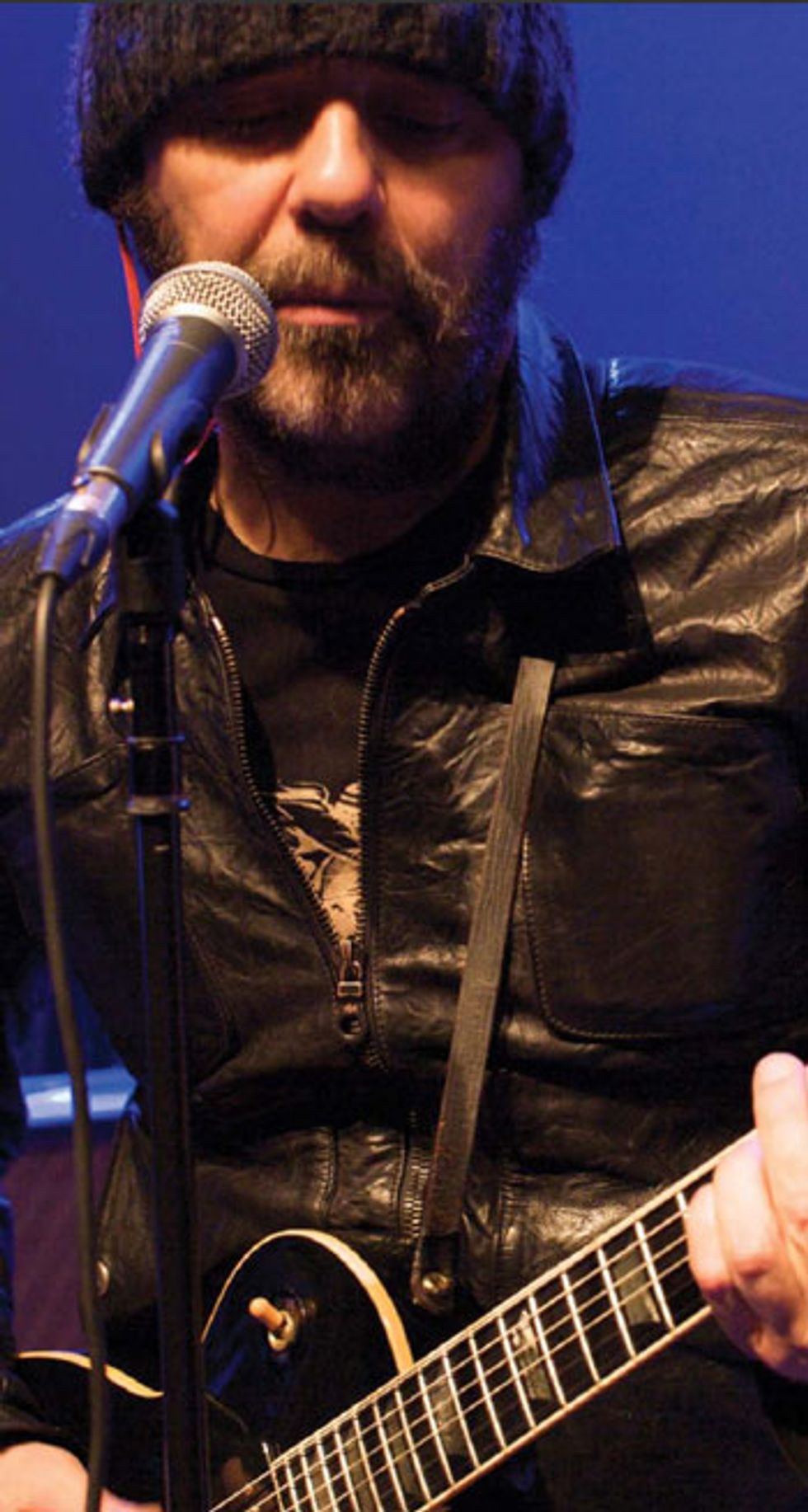 |
If Lanois has a knack for guitar tones, it’s because he’s also an exceptionally inventive player. Solo efforts like The Beauty of Wynona and the soundtrack to Billy Bob Thornton’s Sling Blade showcase Lanois’ masterful sense of touch, space, and composition, and his dark and haunting Belladonna reveals a remarkably expressive pedal-steel technique.
In his latest project—a band called Black Dub—Lanois explores music in the context of an ensemble. Working with vocalist Trixie Whitley, master drummer Brian Blade, and bassist Daryl Johnson, Lanois has forged a somber, celebratory, and groove-heavy sound. The band’s debut album, Black Dub, frames Whitley’s expressive vocals in a spacious sonic environment that’s quintessentially Lanois.
Fresh from receiving clearance from his doctor to tour after recovering from a motorcycle accident that broke 10 bones, the modest, soft-spoken, genial, and gentlemanly Lanois chatted with Premier Guitar about getting big results from lean production, capturing unique tones, and how he crafts some of the spookiest guitar sounds in the business.
Though you produce contemporary music, you draw inspiration from timeless musical sources. What sounds turned you on in your formative years?
Coming up in Hamilton, Ontario, the radio was my source of knowledge. The Motown thing was happening. I also liked surf music a lot—especially its story-telling aspect. I was into the Surfari’s “Wipe Out,” but I really like the flip side, “Surfer Joe.” For a kid who hadn’t traveled much, Surfer Joe sounded like a pretty cool character. When music got psychedelic, I was fascinated with the sonic experimentations. I started getting the impression that there were no boundaries and you could go after whatever you were dreaming about. I’ve been operating that way ever since.
Did any guitar players from that period make an impression?
Jimi Hendrix was probably the most visible. He’s still one of the greats for me—maybe the greatest. I heard “Foxy Lady” and thought, “That’s where I want to go.” I also really like the instrumental music of the late ’50s, like Santo and Johnny.
Which records of the period became production touchstones for you?
I never listened to records for production value or thought of the word production or thought I’d be a producer. I only loved records for how they made me feel, and I was inspired by that more than technique. And really, falling in love is probably the first stage of production.
You’re a very sensitive, inventive, and melodic player, but you’re not too doctrinaire about technique. Has that helped you stake out some of your own ground?
A big part of finding my voice as a guitar player was right-hand technique. I studied fingerpicking as a young player. Some of it was classical, some of it was Travis picking. But it was mostly very traditional technique that didn’t apply to anything contemporary [laughs]. But it became clear this was a unique way to play when most other players were just using a flatpick. At this point, I’ve almost banned the flatpick altogether.
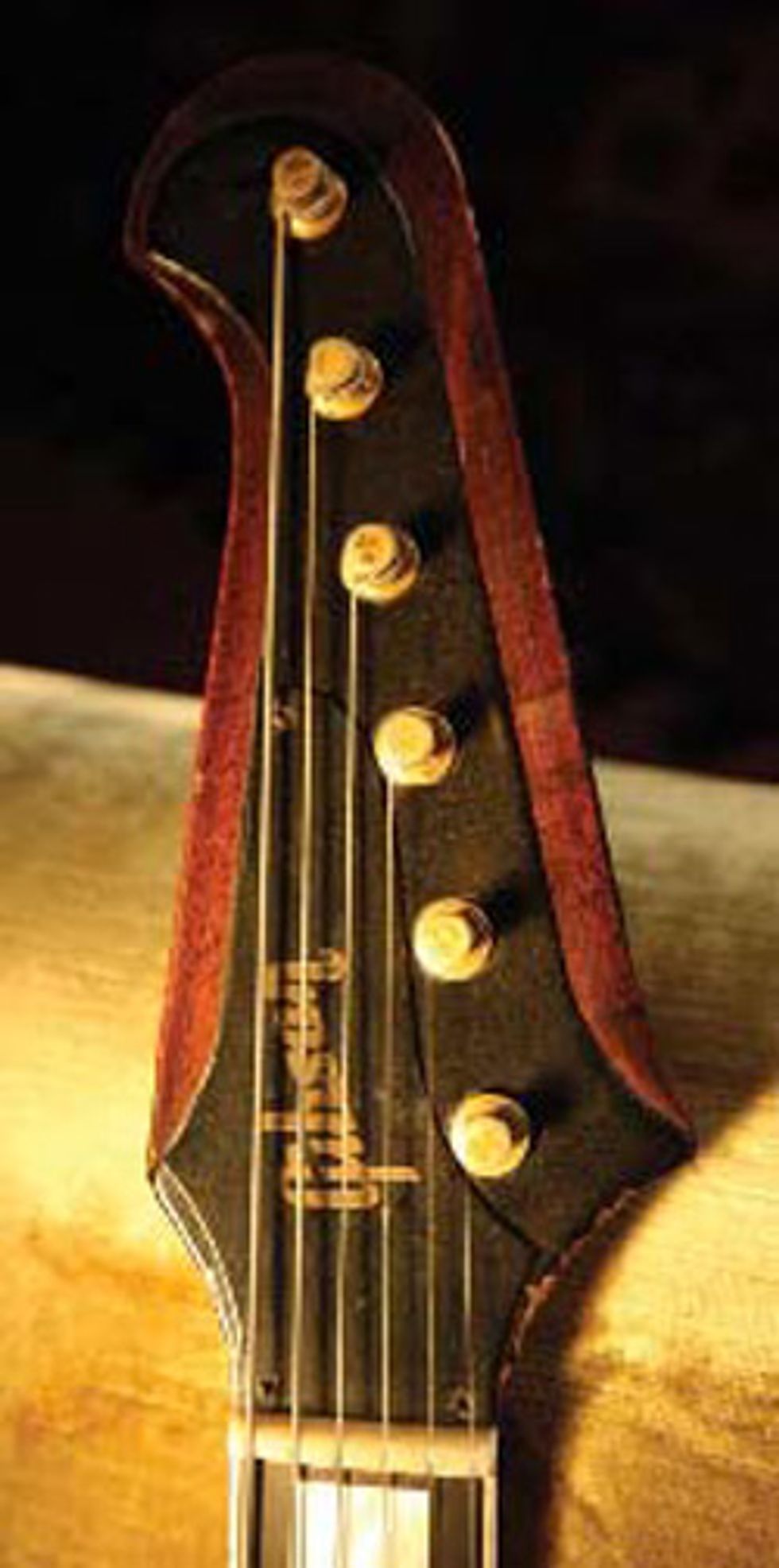 |
Maybe it’s as simple as flesh on steel, versus plastic on steel. It promotes a certain kind of tone I like. And tone often commands a direction for playing. When I get my tone going through that approach, I don’t feel any inclination to play fast, which lends itself more to nice melodies.
In the capacity of producer, what do you look for in a guitar solo?
Pretty early on in a project, I’ll build a menu of sounds from the work at hand—things that help us find a personality for that record. Projects are very sound driven, initially, and someone might play something interesting that I’ll document and add to the menu for that project. I’ll often try to steer the guitar player to those sounds and try to harness them over the course of the project. The idea is to remind them of their most unique expressions.
While there are signature sonic qualities and atmospheres in Daniel Lanois productions, few of your records sound the same. Is that something you strive for, or are you just responding to the needs of the artist?
My taste is evolving all the time, and the things I get excited about change. If you look at the ambient chapter of my work, five to seven years later I’m doing very different things. What’s driving me philosophically or spiritually is pretty important, too. That’s where it gets fascinating. I tend to take on a project or work with a group because I like the people and think they have something in their hearts and their heads that will take the music to an innovative place. That’s what I look for, even now on the Black Dub record. I believe in [Black Dub singer] Trixie Whitley— she’s a deep soul and I’ve been a friend of the family. So I trust that association spiritually and I believe it has reason to exist beyond specifics of music. Having those connections is what inspires you and gets you through the work. If I’m surrounded by deep souls, I know I can trust the music in the end.
I suppose that personal empathy is vital even for a garage band.
That and the existence of a garage! [Laughs.] That’s important too—the idea of working with what you’ve got. I love the resourcefulness that comes from the garage. I’m not in a garage as we speak, but it’s pretty close—pretty renegade.
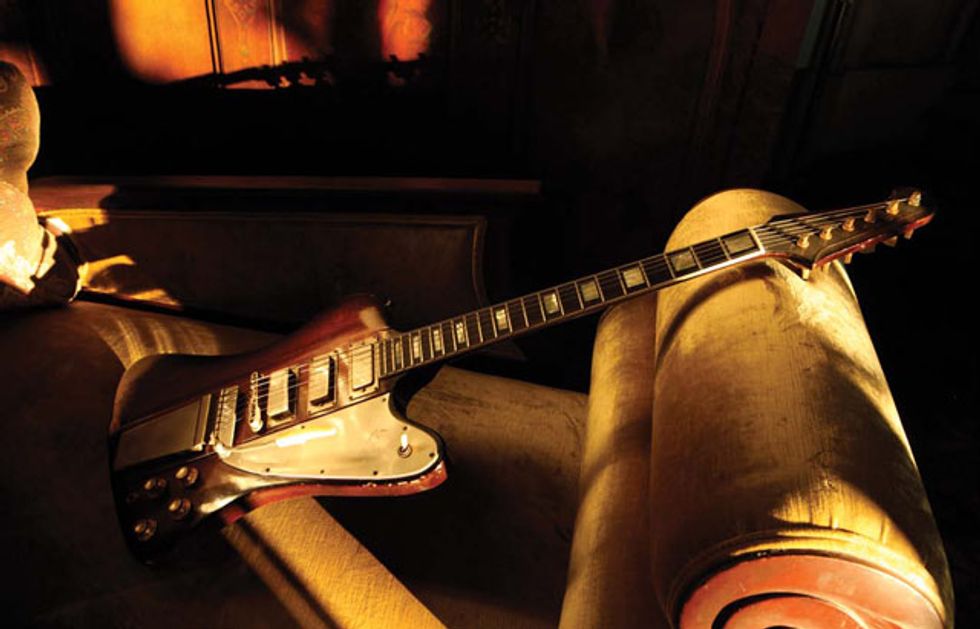
Lanois’ ’60s Gibson Firebird V—which he loves to plug into a cranked amp for delicate fingerstyle work—rests on a golden divan. Photo by Melinda Dahl
You seem to interact with the guitar quite physically. Seeing you play live, it’s sometimes difficult to see how you achieve some of your modulation effects. Do you get most of it from leaning a bit on the guitar neck or do you use a processor?
It’s mostly the fingerpicking angle and bending the neck. But I always try to harmonize with the singing too—which usually involves a lot less strumming—and that kind of playing invites that bending approach. The bending of the neck lends that tiny bit of vibrato that probably sounds a bit different than a whammy bar. It’s a lesson I learned from Jimi Hendrix, because he was always leaning on something and fooling with pitch, whether it was the whammy bar or the neck.
”Slow Baby” is a great showcase for that.
I actually did that with my goldtop Les Paul and a Vox AC30—no effects, just neck wobble and a lot of volume.
Is “Sirens” all looping?
That’s a Boomerang pedal. I’ll work with loopers by putting something in—maybe a minute-long section—and just stack things up. That usually makes for a very long piece, then I go back and shorten the whole thing to three minutes paying attention to every chapter and removing the dead wood. But “Sirens” is all one take—no overdubs except the Boomerang processing—plus an edit to trim the fat. I got what I got. I’m not sure I could ever do it quite that way again, which is some of the beauty in it.
How does playing with a vocalist affect your guitar approach?
I stay out of the way! [Laughs.] I use the old Frank Sinatra big-band technique: When Frank sings, no horns. When Frank stops, baa boo dop, boo dop!
Working as a producer must instill a sense of economy as a player.
Well, I’ve learned it’s nice to not have a muddle come mixing time. It’s best to be lean and somewhat specific about your playing so you don’t have a bird’s nest at the end. It’s what I love about more riff-based music, funk music.
It’s usually quite lean in its structure. It’s taken me a while to get to that place myself. But the results show up on the Black Dub record quite nicely. A lot of the most beautiful productions I’ve been involved with were empty landscapes. I love U2’s “With or Without You” because the rhythm section occupies the bottom, but there’s nothing in the midrange, save for the vocal, because The Edge’s guitar is in the stratosphere. When you hit on a successful but really spare blend like that, it lives on like a beacon forever to remind you how good lean and mean is.
Your pedal-steel playing is so lyrical and immediate. Do you feel it offers a purer expression of yourself—or a certain side of yourself—than other instruments?
There are two aspects of the pedal steel that keep me really interested in it—melody and the fact that I get better results the less busy I play. Those things pushed me in a certain direction that’s very unlike the high-speed Western swing pedal steel players. I love that sound, but I don’t do it at all. I chose to slow the thing down and really let it breathe—which makes it a whole new instrument, sonically and compositionally. Sometimes I think about steel guitar like a string quartet—at any given time you can have four notes interplaying. It’s still mystifying to me. But you can’t put it down for too long, or you’ll lose your technique and the ear for it. And every note really demands attention on a pedal steel.
How did your recent sessions with Neil Young go?
It went really well. He’d seen the Black Dub videos on YouTube and fell in love with them. He really liked that the camera was filming from the perspective of a single individual and that it captured a true live performance rather than being reshaped in the editing room. So, initially, he asked if we could do that—film him and make an acoustic solo record. And it went from that to something much more fascinating over the journey. We employed the Black Dub approach I’ve been using, which is very much inspired by the work of [legendary reggae and dub producer] Lee Scratch Perry. But rather than using just echoes, the way he did, I pull individual elements out of a recording, manipulate them in multiple and more subtle ways, and put them back in the tapestry in such a way that you can’t really see the sutures. In the end, we got a massive electric-guitar sound.
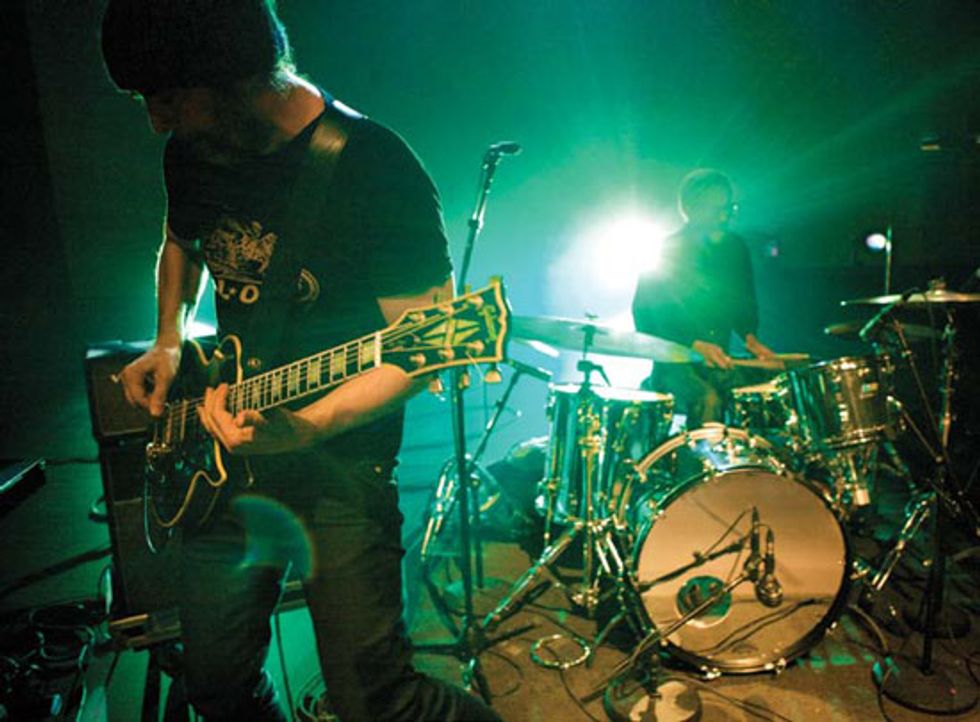
Lanois and his Bigsby-equipped Les Paul get into the groove with
Black Dub drummer Brian Blade. Photo by Adam Vollick
How did you get such a massive sound?
When Neil called, I had a renegade setup in the foyer of a house in Los Angeles, which Neil really loved. The big secret weapon, though, was Neil’s Gretsch White Falcon, which has a pickup that’s split, so the three bass strings come out one jack and the three top strings come out the other. We’d route those to two different amps, and that was the beginning of the new expansive Neil Young electric sound. I could treat the three bass strings differently for a certain part of the song—and, man, I loved that! That was fun.
Did you have any trepidation about working with Neil, given his well-documented aversion to production?
I always have fears. I’m a human being. But I combat fear with preparation. So I spent a couple of weeks preparing for Neil—working with potential guitar sounds, vocal sounds, and even on the film end—really working on shots and lighting with the cinematographer so that when Neil walked in, I had something to offer him. Then I just handed him my little Guild acoustic, which gave him a whole new sound he hadn’t heard before. And once he heard that, he was really inspired to start. If he’d walked into a blank studio with a lot of handshaking, we wouldn’t have had that stepping-off point.
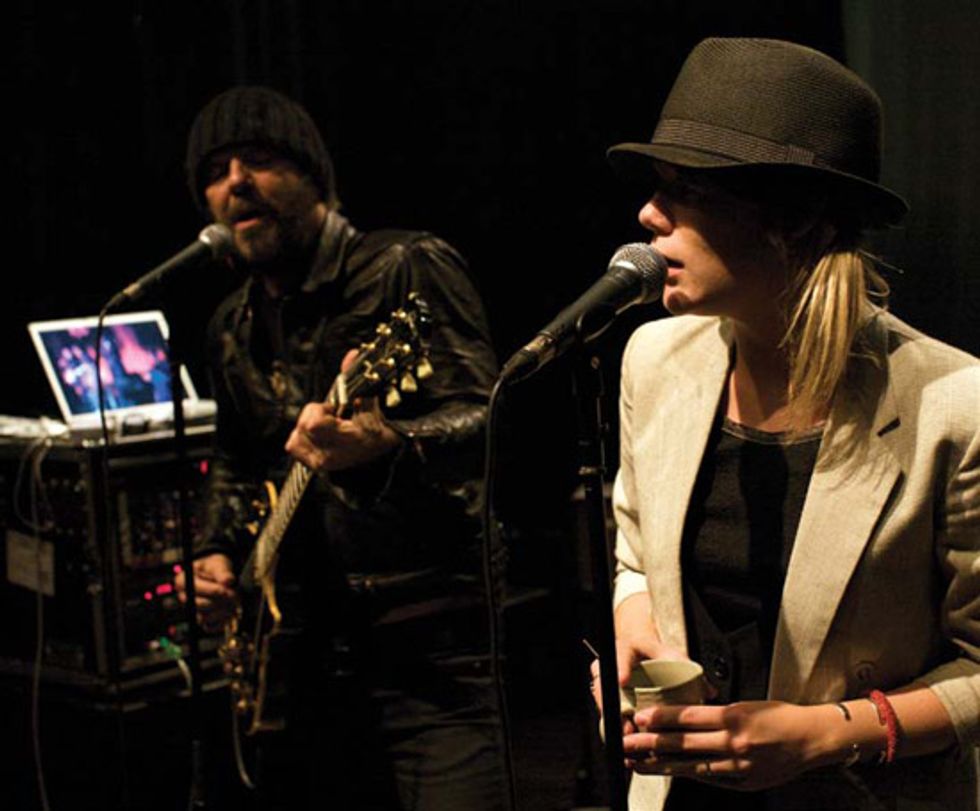
Lanois onstage with Black Dub vocalist Trixie Whitley. Photo by Adam Vollick
They’re very different processes. But even for Peter and U2, who really push for newness and originality and take a lot of time doing it, raw performance is still a friend. The end of Peter Gabriel’s “Sledgehammer”—the whole ad-lib section at the end—happened in a very spirited moment that lived very far away from the initial rhythmic discoveries the song was built on. And I think all these artists, no matter how different, want some spontaneity and freshness and for the thing to have some combustion. Artists who like first takes—Neil Young, Dylan, and certainly Willie Nelson—you just have to be ready for them. You learn to treat the studio like a stage and create an atmosphere that invites a good performance. But you also make sure everything is right—no crackles and hum. The worst thing you can do is say, “Stop everything, we have a broken cable.” But I tend to live beyond those concerns now, just through preparation.
After worrying about someone else’s work so deeply, it must be nice to do something more personal, immediate, and seat-of-the-pants— like a solo instrumental piece or the Sling Blade soundtrack.
There’s something wonderful about singularity, and I love going to that place where there’s no interruptions, no outside opinions or influence. I just find my center, find my sound, and out of that emerges a pretty pure form. I feel that way when I’m playing pedal steel, certainly. Being alone is probably the setting that enables me to get to the deepest within myself as a player.
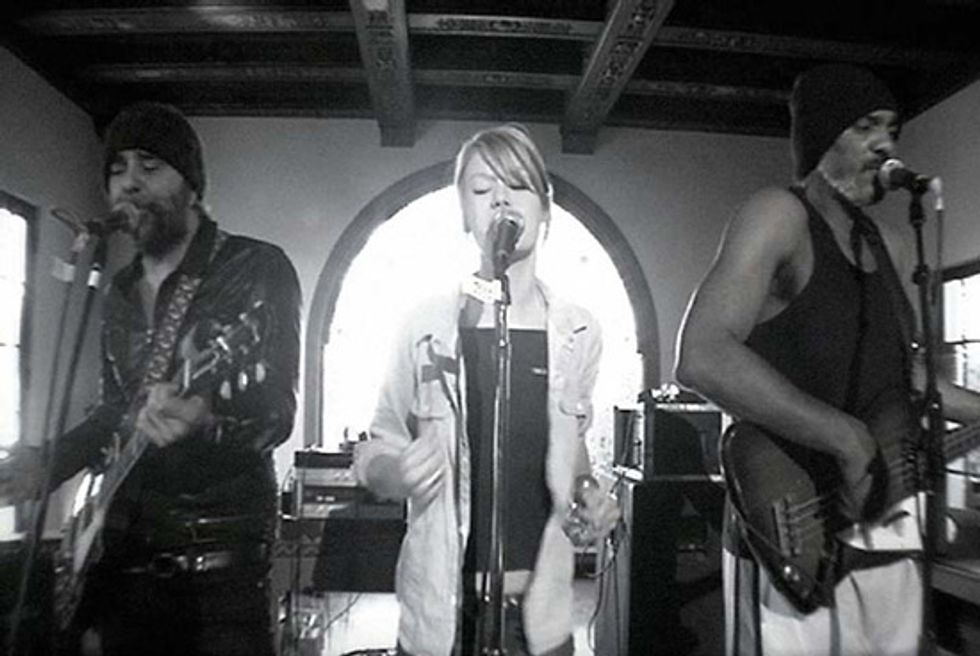
Lanois, Black Dub singer Trixie Whitley, and bassist Daryl Johnson
during their YouTube video sessions. Photo by Adam Vollick
I wish I could have produced Ali Farka Touré. Every now and again I hear something in African players where it sounds like they’re finding something on the instrument that we’re not. It’s a fascinating style.
Do you look for a guitar that has a certain kind of voice or one that’s more versatile?
I keep instruments around for specific aspects of their sound. I still have my white Fender Mustang, which you can use with the two pickups out of phase, which sounds wonderful when you play with a soft touch and the amp really cranked. I also have an old butterscotch Telecaster, which I think might be a ’51, and when I shake the neck on that thing, the pickup, which is a little loose, makes this mad sound like something’s trying to crawl out of the guitar—especially when I’m running it through an echo. I use my Vox MandoGuitar a lot and my little brown Guild with an L.R. Baggs M1 pickup, which is what we used with Neil. I have some really nice Martins and Gibsons, but that little guitar records wonderfully.
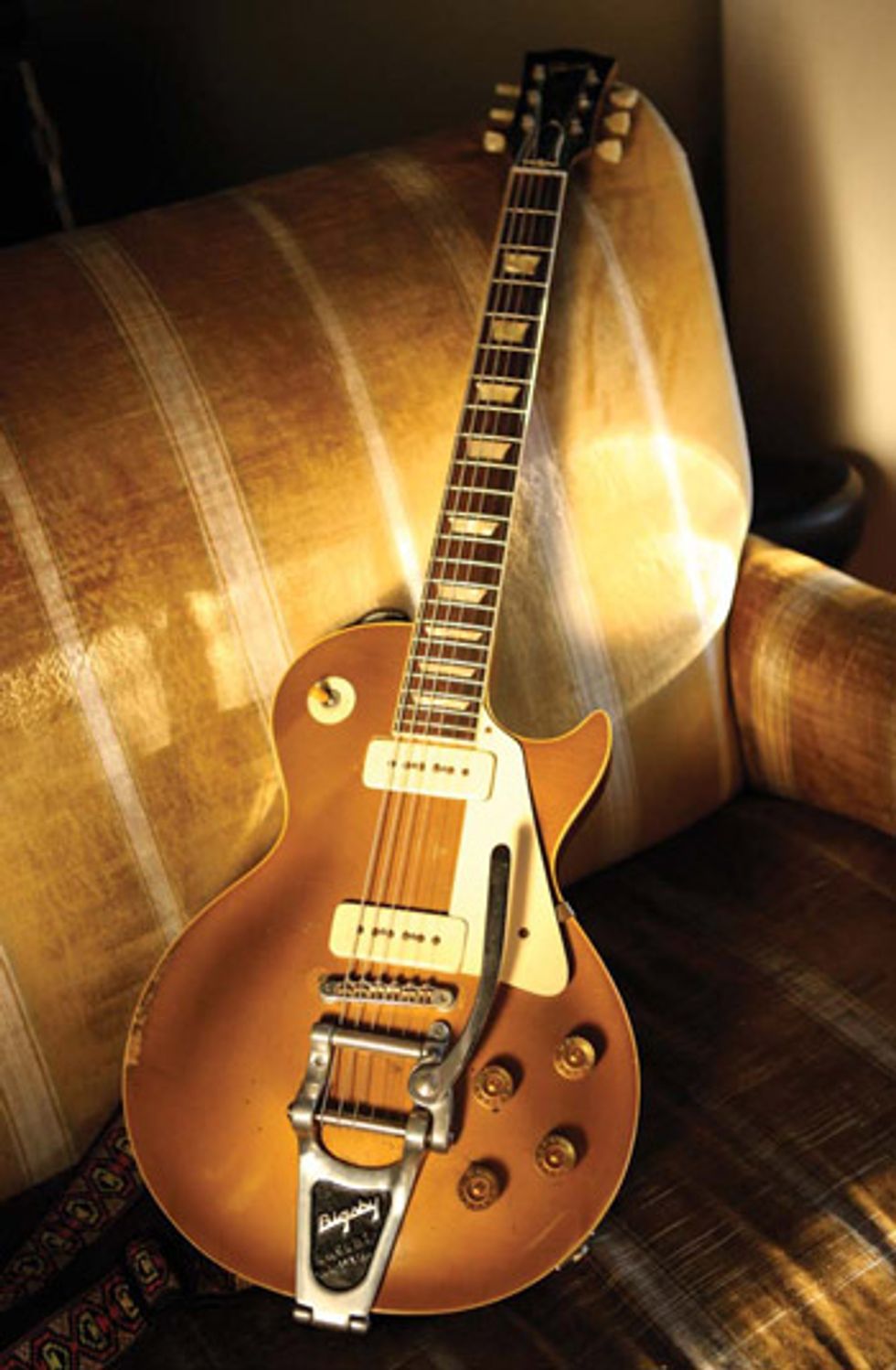 |
I’m a P-90 player. But when I want to do something really delicate, where I turn the amplifier up and play really softly, the humbucker is a friend. Firebirds are really good for that.
What about amplifiers?
I usually play ’50s tweed Fenders because they’re just the most musical sounding amps, and at low volume they have the most beautiful tone. The natural overdrive on those tweeds can produce fascinating results too. But I’ll do things like put a Vox 12" speaker in a tweed, because the Vox speakers will handle a lot more volume and have more headroom. That’s a really interesting combination of sounds. And tweed combos weigh a lot less than an AC30! I like hitting the amp with overdrive sources too, though. The Korg SDD-3000 digital delay is a big part of my sound, too, which is something I got from The Edge. Even if you don’t use it as a delay, you can get a nice boost out of it.
Are you a pedal nut?
I’ll use the Boomerang a lot. Occasionally, I’ll use a fuzz wah for a little more tone variation. But the truth is, I don’t really like playing with my feet [laughs]. When you don’t do too much pedal work, it makes you resourceful in other ways.
What do you make of players who go to great effort to emulate other players’ style and tone?
Well, we enter this world as admirers. And we’re obviously inspired by other guitar players and driven by that inspiration. But, ultimately, as they say, students must leave the master’s house to find their own voice. That’s something all of us should try to do, though you certainly can’t teach that. It’s something you do on your own. I can definitely say that about my pedal-steel playing, and I’m glad and lucky I was able to find something in the instrument that belongs to me. I wish that for every guitar player.
Daniel Lanois’ Gearbox
Guitars
’50s Gibson goldtop Les Paul with P-90s and a Bigsby tremolo, ’60s Gibson Firebird V, ’50s Fender Telecaster, ’60s Fender Mustang, ’60s Guild M-20 with L.R. Baggs M1 pickup
Amplifiers
’50s Fender Deluxe, ’50s Fender Harvard, ’60s Vox AC30
Effects
Boomerang Phrase Sampler, KORG SDD-3000 digital delay
